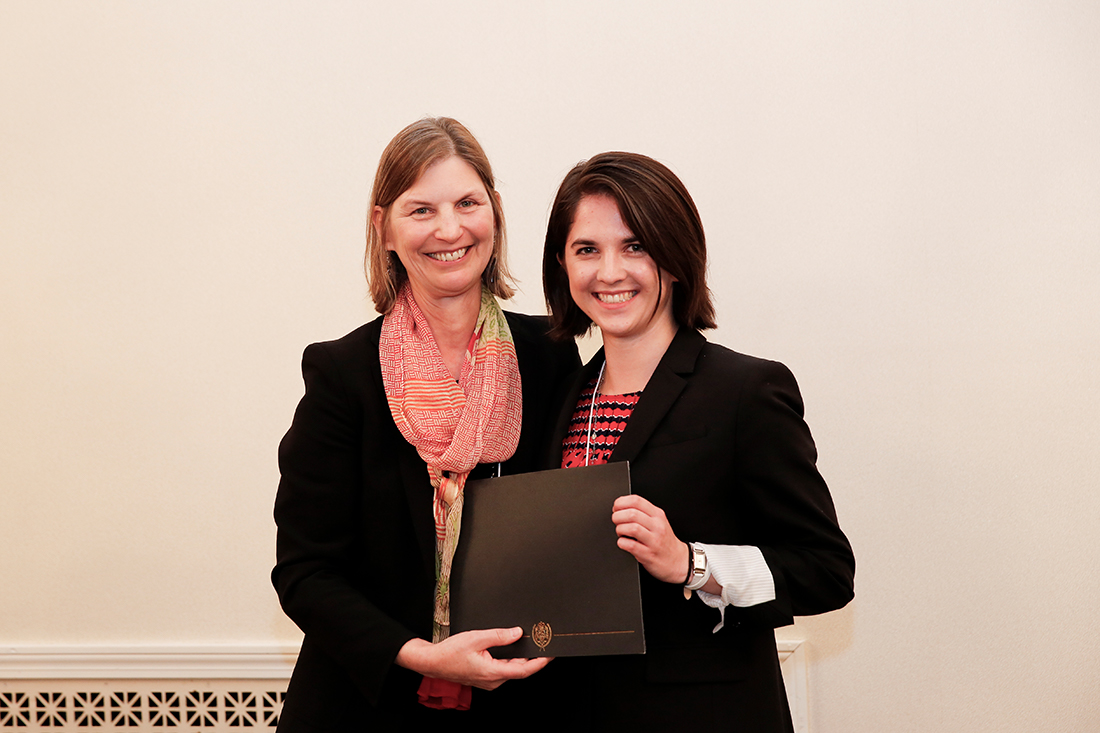By Lily Williams
Undergraduate materials science senior Lauren Kearney heads to Northwestern University’s SpaceICE lab on most days to work on the design for the team’s freeze-casting instrumentation that will launch in a NASA mission next year.
Kearney won one of two of Northwestern’s Hilliard Awards for leadership, scholarship and service. Each year, the university’s materials science and engineering department awards two of its undergraduates the prestigious award.
Kearney studies and works in “matsci” professor David Dunand’s lab, where she is finishing up her senior design project on the surfaces of suspensions that could lead to the production of materials in space. Her project could lend clues into how the interaction between freeze-casting suspensions and air affect the final product when a water removed from frozen suspension leaves a potential building material behind.
Freeze-casting involves suspending microscopic particles in a fluid and then freezing the whole batch. The frozen fluid is then turned directly into a gas and the remaining materials are heated to bind them together in a hardened structure, which could be used for the building materials.
The Hilliard Award recognizes two graduating seniors who “will be a credit to the Department of Materials Science and Engineering, the McCormick School of Engineering and Northwestern University. Lauren is an exemplar of all three criteria important to the award,” said Kathleen A. Stair, professor and assistant chair of the department at NU.
Despite Kearney’s impressive research for testing the manufacture of materials in space, she wasn’t the recipient of the Hilliard Award that honors undergraduate research and design. Rather, she won the one dedicated to leadership, scholarship and service. Kearney has traveled to Nicaragua to work on water and engineering with public health brigades and has served as the vice president of the MatSci Club and chapter vice president of the Phi Sigma Pi National Honor Society.
Most notably, Kearney chose Northwestern for its NROTC (Naval Reserve Officers Training Corps) program, through which she has won national awards and valuable leadership experience, a big factor in her Hilliard Award receipt.
“Last year I had a huge leadership position,” said Kearney of her position as Battalion Executive Officer. This position is normally reserved for seniors, but Kearney earned it her junior year. She assumed she would likely receive a higher leadership position her following year, but another student received the slot.
“My challenge was basically how to be a leader without the authority of one,” said Kearney of the transition. “It was good lesson in humility, I thought I was going to get the big position and I didn’t, so definitely a good experience learning how to fill in the gaps.”
Dunand nominated Kearney for the award based on her multitude of contributions to the freeze-casting project for the NASA mission. He notes her as the only student who works on both the science and payload engineering sub-teams, and for her scholarly approach to her own senior project research.
The SpaceICE payload, or instrumentation package, will launch in a CubeSat, a small satellite that students at the University of Illinois at Urbana-Champaign are building. The mission will test how freeze-casting works and changes in zero gravity.

Dunand also noted that in addition to Kearney’s “demonstrated ability to design and conduct independent research,” she is both a leader and a team member. The SpaceICE team meets for periodic reviews with NASA, the collaborator and source of funding for the project under its Undergraduate Student Instrumentation Program. Kearney has been a vital member in preparations for each of these milestone reviews, working with the other SpaceICE students to make sure the payload design is thorough enough to present to NASA.
“Lauren’s awesome. She really is. She doesn’t do things because she’s trying to get some sort of admiration from other people. She just does it because it’s what she thinks she should do. It’s not uncommon for her to volunteer to do something totally trivial that no one else wants to do but also to be doing something advanced,” said Krysti Scotti, the undergraduate adviser who helped spearhead the SpaceICE team and is now heading into her Ph.D. research, studying with Dunand.
While setting up a suspension for data collection – the critical first step in freeze-casting – Kearney describes her post-graduation plans. She interviewed last week for a position in the Navy’s nuclear program as a division of its Surface Warfare unit with hopes of eventually being stationed in Japan before attending Naval Nuclear Power School and working on a nuclear aircraft carrier.
“I’ve only known one other person in matsci who’s gone into the Navy. Most people I know don’t want to have a nuclear option. They want to go fly,” said Kearney.
The NU school year ends in just a few weeks. During that time, Kearney and the SpaceICE team will do their best to finish designing the payload for CubeSat. Their Critical Design Review with NASA has been pushed back later than anticipated and the team expects it will take place sometime late this summer.
The Hilliard Award launched in 2007 as a tribute to NU Professor John Hilliard, who innovated quantitative 3D pictures of sampled material structures. “We’re very proud of our accomplished students,” said Stair.


